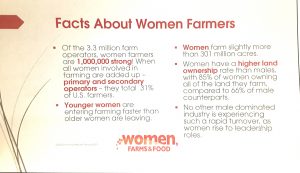I traveled to Fort Worth, Texas last week to attend a training for 2016 Extension Risk Management project directors.

The Land Connection was awarded a risk management grant for a project titled Risk Management for Illinois Farmers Transitioning to Organic and Identity-Preserved Crop Production, but I’m not going to tell you about that project now–We’ll share more about that soon, when we have more details about how to sign up for the workshop series.
After the training, I stayed for the Extension Risk Management Education National Conference, which is what I am going to write about. As is the case at many conferences, choosing which sessions to go to was a challenge–there were five concurrent sessions, and all seemed important, and relevant, to the farmers we work with. So I decided to pick two themes, and stick with them– I chose themes that were on some levels surprising (I didn’t expect whole tracks dedicated to them), yet completely obvious when you look at the statistics–women farmers, and communication. Women were 30% of farmers in the US 2012, and that number is growing–in some states it is closing in on 50%. So it made sense that there was a track at the conference that was dedicated to managing risk specific to women farmers. The sessions included topics from production and operating equipment, to business planning and networking. I was particularly inspired by a workshop for women livestock farmers that included Amazing Grazing, a project of Center for Environmental Farming Systems, and NC Choices, where women learned about working in the local meat supply in hands-on workshops (and there is another one coming up in the fall–check it out).
The other theme that was particularly intriguing to me was communication. It seems somewhat obvious that farmers should communicate with their customers in some way, but what is interesting is that not communicating is very risky–particularly if there are any gaps in information–because if farmers don’t tell their customers, or the public in general, about what they do and how they do it, someone else will. This question actually came up during the luncheon address, by Amanda Freund of Freund’s Farm. Amanda, a young woman in her 20s (I’m guessing), was asked what she thought was different about farming now as compared to farming 20 years ago. She replied that she didn’t think “telling your farm’s story” was part of the job description 20 years ago–but now, you absolutely must. So taking classes on how to talk to the media, for instance, is part of her continuing education. Her point was that there is all sorts of misinformation about dairy farms floating around, and so she has to be sure to communicate what really happens on her farm to the public.
There were also sessions on managing finances, training the next generation of farmers, and a lot of discussion about farm transition. The takeaway being that there are a lot of risks in farming, and that we as educators and support organizations need to be sure we are offering the resources that farmers need. Please, farmers, let us know what you think is important, so that we can offer the training that you need.



